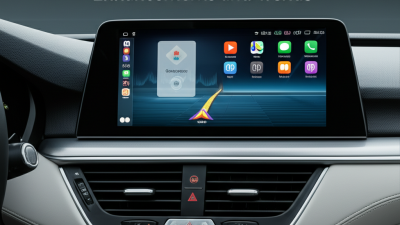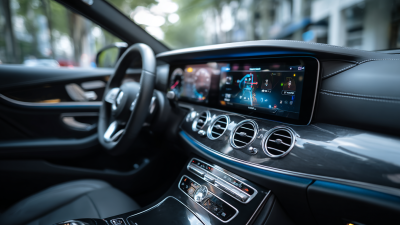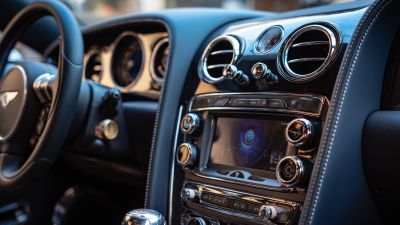Exploring the Future of Car Multimedia Player Technology Enhancements and Trends
The automotive industry is witnessing a transformative shift in in-car technology, particularly with the evolution of car multimedia players. Recent market analysis indicates that the global automotive multimedia market is projected to reach USD 35 billion by 2025, growing at a CAGR of 10.1% from 2020 to 2025. This growth is driven by the increasing consumer demand for seamless connectivity and enhanced user experience within vehicles.
 As automakers focus on integrating advanced features such as voice recognition, touchscreen interfaces, and integration with smartphones, the role of the car multimedia player has expanded significantly.
Enhanced multimedia systems not only improve entertainment options but also play a vital part in navigation, communication, and safety. As we delve into the latest trends and advancements in car multimedia player technology, it is essential to explore how these innovations are shaping the future driving experience, promoting convenience and connectivity in an increasingly digital world.
As automakers focus on integrating advanced features such as voice recognition, touchscreen interfaces, and integration with smartphones, the role of the car multimedia player has expanded significantly.
Enhanced multimedia systems not only improve entertainment options but also play a vital part in navigation, communication, and safety. As we delve into the latest trends and advancements in car multimedia player technology, it is essential to explore how these innovations are shaping the future driving experience, promoting convenience and connectivity in an increasingly digital world.
Emerging Technologies Transforming Car Multimedia Systems
The future of car multimedia systems is heavily influenced by emerging technologies that enhance user experience and connectivity. One of the most significant developments is the integration of artificial intelligence (AI) into multimedia players. AI-driven systems can learn user preferences and adjust settings accordingly, providing a personalized experience.
Voice recognition technology, enabled by AI, allows drivers to control various functions hands-free, making the driving experience safer and more convenient.
Another transformative trend is the advancement of connectivity features, particularly with the rise of 5G networks. This allows for seamless integration of cloud-based services within car multimedia systems, providing real-time updates on navigation, music streaming, and even vehicle diagnostics.
Augmented reality (AR) is also making waves by enhancing navigation systems with visual overlays, guiding drivers in complex environments. As these technologies evolve, car multimedia systems are set to become more intuitive, making routes more enjoyable and keeping passengers entertained like never before.
Seamless Integration: Connecting Smartphones and Vehicles
As car multimedia player technology continues to evolve, seamless integration with smartphones has emerged as a critical trend. According to a recent report by MarketsandMarkets, the global automotive infotainment market is projected to reach $47.4 billion by 2025, growing at a CAGR of 10.8% from 2020. This growth is largely driven by the increasing consumer demand for connected experiences, where smartphones serve as a hub for navigation, music, and communication functionalities within vehicles.
One notable advancement in this domain is the implementation of wireless smartphone connectivity options such as Apple CarPlay and Android Auto. These systems allow users to access their smartphone applications directly from their car's display, thereby enhancing the driving experience while maintaining safety. Research from Deloitte indicates that approximately 35% of new vehicles sold globally are now equipped with some form of smartphone integration, which signifies a rapid shift towards more connected automotive environments. The integration enhances not only convenience but also customization, allowing drivers to tailor their multimedia experiences in ways that were not possible before.
User Experience Innovations in Touchscreen Interfaces
Touchscreen interfaces are rapidly evolving, playing a critical role in enhancing user experience in car multimedia player technology. As forecasted, the global audio market for vehicles is expected to grow from approximately $11 billion in 2025 to $18.1 billion by 2032, with a compound annual growth rate (CAGR) of 7.2%. This growth is driven by innovations in interconnected technologies, notably through advancements like the latest in-vehicle systems equipped with over-the-air (OTA) update capabilities, which enhance functionality and user engagement.
The emergence of gesture recognition technology further enriches the user experience by facilitating intuitive interactions. With the rise of augmented reality (AR) and virtual reality (VR), there is an increasing demand for seamless real-time hand tracking, allowing users to navigate through multimedia environments more naturally and effectively. The touchscreen display market itself is projected to expand significantly, from $850 billion in 2025 to $1.417 trillion by 2033, signifying a CAGR of 6.6%. These trends highlight a concerted push towards creating more immersive, user-friendly interfaces that resonate with modern consumer expectations in automotive technology.
Sound Quality Enhancements: The Future of In-Car Audio
As automotive technology evolves, the enhancement of in-car audio systems becomes a focal point for manufacturers aiming to attract consumers seeking unparalleled sound quality. Recent advancements have led to the production of high-end DSP audio chips specifically designed for car audio systems, capable of supporting up to 256 audio channels. This technology significantly improves the auditory experience by allowing precise digital signal processing, which ensures cleaner sound and better overall audio fidelity.
Partnerships between leading audio solution manufacturers and automotive brands are also paving the way for superior sound experiences in vehicles. For instance, collaborations are being formed to integrate high-fidelity audio systems that promise to deliver immersive sound environments tailored to the demands of modern drivers. According to a report by iiMedia, the surge in electric vehicle production is positively impacting the audio equipment supply chain, leading to enhanced user experiences and a growing market for advanced car audio solutions. The integration of AI technologies into the audio industry further revolutionizes how sound is processed and experienced within vehicles, setting a new standard for in-car audio quality and personalization.
Trends in Voice Recognition and AI for Driver Convenience
Voice recognition technology is revolutionizing the way drivers interact with their vehicles, transforming traditional car multimedia players into advanced hubs of convenience and control. As the demand for hands-free functionality grows, automotive manufacturers continually enhance their systems to ensure seamless integration with smartphones and other devices. This evolution allows drivers to access music, navigation, and communication features through simple voice commands, minimizing distractions and promoting safer driving practices.
Artificial intelligence plays a crucial role in refining voice recognition capabilities, making them more accurate and responsive. Next-generation AI algorithms can learn and adapt to individual speech patterns and preferences, allowing the system to process commands more effectively. This trend not only enhances user experience but also paves the way for increasingly sophisticated driver-assistance features. By leveraging voice recognition and AI, the future of car multimedia technology promises an intuitive and efficient driving experience, where technology becomes an empowering tool rather than a source of distraction.
Exploring the Future of Car Multimedia Player Technology Enhancements and Trends - Trends in Voice Recognition and AI for Driver Convenience
| Feature | Description | Current Trend | Future Predictions |
|---|---|---|---|
| Voice Recognition | Allows drivers to control multimedia options using voice commands. | Increasingly accurate models using machine learning. | Seamless integration with smart home devices and continuous learning capabilities. |
| AI Personal Assistants | AI systems that learn from user preferences to enhance driving experience. | Tailored recommendations for music, routing, and vehicle settings. | Full contextual understanding with predictive analytics based on user habits. |
| Gesture Control | Enables control of multimedia features through hand gestures. | Development of more responsive and intuitive gesture-based systems. | Integration with augmented reality displays for enhanced navigation. |
| Connectivity | Linking car systems with user devices and cloud services. | Increased use of 5G networks for faster data transfer. | Real-time updates and remote troubleshooting capabilities. |
| Safety Features | Voice commands to access emergency services and navigation for safety. | Enhanced focus on driver distraction reduction. | Fully integrated safety monitoring with AI detection systems. |
Related Posts
-

Transform Your Ride: The Ultimate Guide to Choosing the Best Car Multimedia Player in 2023
-

How to Select the Best Car Audio System for Optimal Sound Quality Based on Industry Insights
-

The Future of Mobile Audio How 5G is Transforming Sound Quality and User Experience
-

Unlocking Opportunities: Car Electronics Trends at the 138th Canton Fair 2025 in China
-

Maximizing Your Drive: The Ultimate Guide to Choosing the Right Car Audio System for an Enhanced Sound Experience
-

Why Investing in a High Quality Car Audio System Elevates Your Driving Experience
Footer

Hours
| Sunday | CLOSED | |
| Monday | 9AM-12PM | 1PM-6PM |
| Tuesday | 9AM-12PM | 1PM-6PM |
| Wednesday | 9AM-12PM | 1PM-6PM |
| Thursday | CLOSED | |
| Friday | 9AM-12PM | 1PM-6PM |
| Saturday | 10AM-12PM | 1PM-6PM |
Please note that we are closed for lunch from 12PM-1PM daily.
Contact Us
Leave us a Review!
Our Services
- Car Audio
- Car Alarms
- Mobile Video
- Remote Car Starters
- Navigation Systems
- Backup Camera Installation
- Apple CarPlay Installation
- Android Auto Installation
- Device Integration
- Key Fob Programming
- Interlock Installation
- HID Headlights
- LED Headlights
- Underglow Lighting
- Marine Audio
- Custom Fabrication
- Custom CNC Machining Services
- Mobileye Installation Services



